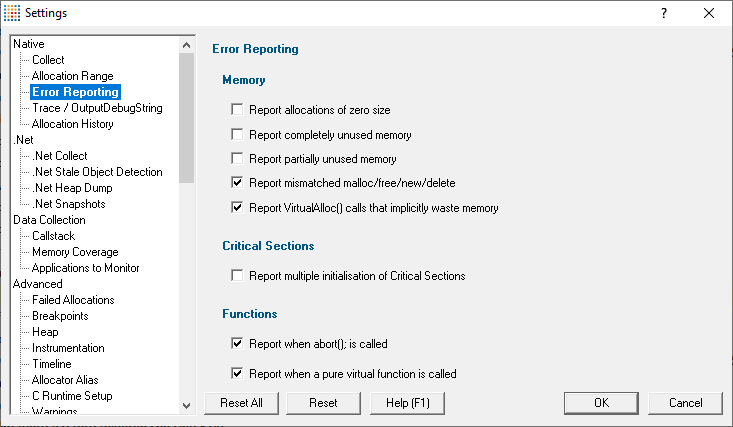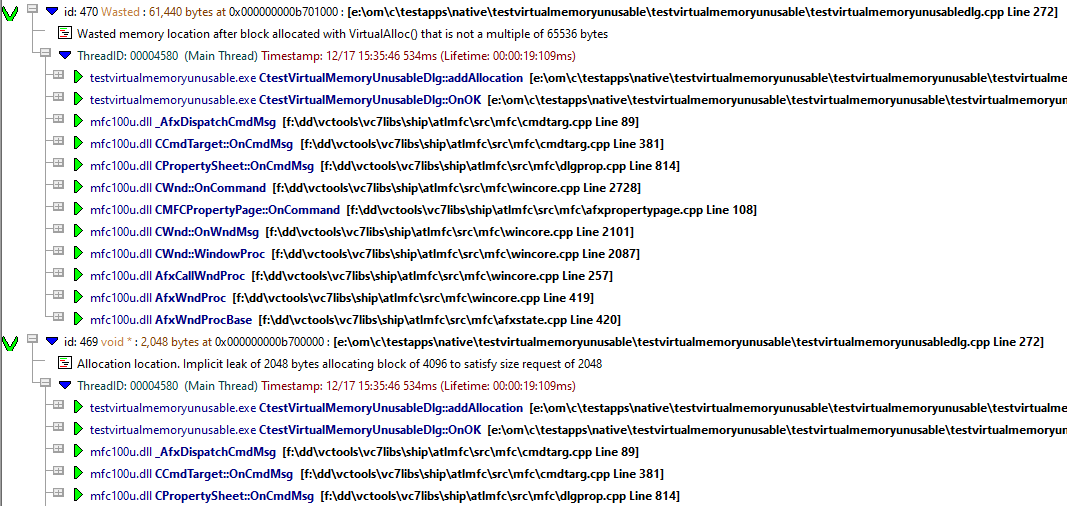The Error Reporting tab allows you to check for a few special conditions that can stop the target program using a warning dialog or breakpoint
 Read on, or click on a setting in the picture below to find out more
Read on, or click on a setting in the picture below to find out more

Memory Errors
When allocating CRT memory Memory Validator looks for two conditions that may indicate a programming error, or programming oversight.
•Report allocations of zero size  enable the detection of zero size allocations showing the warning dialog in the breakpoints topic
enable the detection of zero size allocations showing the warning dialog in the breakpoints topic
Zero byte allocations are valid, but not normally something that is done. Bugs come about for example because memory blocks of zero length are allocated and then used, or perhaps not deallocated because the logic looks for a byte count rather than a non NULL pointer.
An example report in the Memory tab:

•Report unused memory  enable the detection of memory which is allocated, but later deallocated without actually having been used
enable the detection of memory which is allocated, but later deallocated without actually having been used
This sometimes happens due to the logic of the function in which it occurs. Or maybe the memory was once required but the source code has changed and the person that changed the code has forgotten to remove the allocation and deallocation code.
An example of what you might see in the Memory tab:

Improving application performance: for each of the above cases, if this either of these conditions is detected it may be possible to modify the code to remove the allocation and deallocation and thus improve program performance by reducing the use of the heap manager and reducing memory consumption.
•Report partially unused memory  enable the detection of memory allocated, but which is then later deallocated without all of it having been used
enable the detection of memory allocated, but which is then later deallocated without all of it having been used
•Report mismatched malloc / free / new / delete  enables detection of an inappropriate deallocation method compared to that used for allocation
enables detection of an inappropriate deallocation method compared to that used for allocation
Allocated memory must be freed with the correctly paired deallocator:
•new •new [ ] •malloc |
On detection of mixed use, a report will appear in the Memory tab as below:

•Report VirtualAlloc() calls that implicitly waste memory  enables detection of VirtualAlloc() calls that implicitly waste memory because the allocation size requested is smaller than the minimum allocatable size for VirtualAlloc().
enables detection of VirtualAlloc() calls that implicitly waste memory because the allocation size requested is smaller than the minimum allocatable size for VirtualAlloc().
On detection of implicitly wasted memory the wasted memory will be reported in the Memory tab when you refresh the display.
There are two entries. The first entry (469 below) is for the VirtualAlloc() allocation. It also describes any implicitly leaked memory in the allocation - memory up to the next page boundary. The second entry (470 below) describes the free memory that follows the allocation (starts on the page boundary following the allocated memory).

 False positives: note that Memory Validator detects unused blocks of memory by looking for an entire memory block with the uninitialized data signature. There may be rare occasions when the software has filled the entire memory block with the same signature. This will result in a false error report, but inspection of the source code should allow this to be validated.
False positives: note that Memory Validator detects unused blocks of memory by looking for an entire memory block with the uninitialized data signature. There may be rare occasions when the software has filled the entire memory block with the same signature. This will result in a false error report, but inspection of the source code should allow this to be validated.
Other conditions which are checked
In addition to the above conditions, the following conditions are also checked for:
•Zero size allocation
•Negative size allocation
•Bad reallocation
•Bad deallocation
•Bad pointer to C heap
•Bad start of C heap
•Bad node in C heap
•Damage in C++ heap
•Damage in Release CRT heap
InitializeCriticalSection
•Report multiple initialisation of Critical Sections  checks if CRITICAL_SECTION objects are initialized more than once
checks if CRITICAL_SECTION objects are initialized more than once
This error typically does not cause a problem in any program execution, but you may wish to find and remove the cause of these errors.
You may also find that some third party DLLs cause these errors. DLLs by nVidia often seem to generate these errors.
Handles
CloseHandle() should only be called when all file locks have been unlocked. Memory Validator can detect when locks are still active. If you are having problems with file locks, you may want this option enabled.
•Detect locked file when CloseHandle() is called  use data from LockFile(Ex) and UnlockFile(Ex) to determine if CloseHandle() is being called before UnlockFile(Ex) has been called.
use data from LockFile(Ex) and UnlockFile(Ex) to determine if CloseHandle() is being called before UnlockFile(Ex) has been called.
This error typically does not cause a problem in any program execution, but you may wish to find and remove the cause of these errors.
•Report LockFile(Ex) failure  when LockFile() or LockFileEx() fail, report the failure and the Win32 error code.
when LockFile() or LockFileEx() fail, report the failure and the Win32 error code.
•Report UnlockFile(Ex) failure  when UnlockFile() or UnlockFileEx() fail, report the failure and the Win32 error code.
when UnlockFile() or UnlockFileEx() fail, report the failure and the Win32 error code.
Reset All - Resets all global settings, not just those on the current page.
Reset - Resets the settings on the current page.